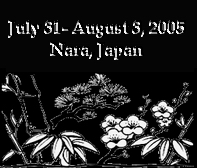
|
LINKS |
Special Session on
Pen-Based Mathematical Computing
Conference on Applications of Computer Algebra (ACA) 2005
July 31 - August 3, 2005. Nara, Japan
Talk Abstracts
-
An Authoring Tool for Math Web with Pen-based Formula Input Interface,
Masakazu Suzuki (Kyushu U., Japan)Math Webs -- from large Web-cource systems to personal Web sites of teachers -- are giving an important new prospect in education for both students and teachers. However, the exisiting math web sites are, in most cases, copies of printed math texts or some extracts of them. At current stage, the development of easy methods to author more "dynamic" and "interactive" math web is desired for the success of web-based or web-assited education of mathematics. In the talk, as a first step toward this direction in our research project Infty (http://www.inftyproject.org/), I will present an authoring tool for math web having blank boxes (answer boxes) in which students can input math expressions using pen-interface. The blank boxes return some actions depending on the answers input by students.
[pdf] -
Structural Analysis for Pen-Based Math Input Systems,
Ian Rutherford, George Labahn (U. Waterloo, Canada)In this talk we will describe a real-time method for interpreting handwritten mathematics on a pen-input device. The general problem is to convert two-dimensional handwritten math into a mathematically correct expression. In our case, the conversion of our handwritten expression is stored as an annotated MathML tree, allowing us to interact with existing computer algebra systems such as Maple and Mathematica.
[pdf] -
AsirPad -- A Computer Algebra System with Handwriting Interface on PDA,
Mitsushi Fujimoto (Fukuoka U. of Education, Japan), Masakazu Suzuki (Kyushu U., Japan)Infty Editor is a editor with on-line recognition of handwritten mathematical expressions, which was developed by our research group. We ported the handwriting interface of InftyEditor to Linux PDA Zaurus. OpenXM(Open message eXchange for Mathematics) is an infrastructure for mathematical communication. We added OpenXM translator and communication controller to this interface, so that one can carry out calculations for mathematical expressions inputted by handwriting. As a result, we developed a computer algebra system AsirPad with handwriting interface on PDA (See demo movie.) Furthermore, we gave a lecture about RSA cryptography at a junior high school using AsirPad. In our talk, we will explain the details of AsirPad, and report the results of the lecture.
[pdf] -
Pen-Based Proofs,
K. Sutner, V. Adamchik (Carnegie Mellon U., USA)We present a preliminary evaluation of an outgoing project for developing a learning system for pen-based proofs in computer science. The cornerstone of the system is the concept of geometrical sketching dynamically combined with an underlying mathematical model. The system is based on several sophisticated software libraries and packages, such as a gesture-understanding MagicPaper (MIT), the computer algebra system Mathematica, and the theorem-prover Analytica (CMU). The primary goal of the project is to develop a library of domain-based gesture recognition tools, that eventually will serve as a foundation for future pen-based interfaces to computer algebra systems. The challenge for us is getting the computer to recognize different types of geometrical drawings - to determine which parts of the sketch are intended to represent a circle, a straight line, or a polygon. On a more detailed level, the computer must distinguish a circle from an ellipse, a rectangle from a trapezoid, and so on. Another core technique with smart digital ink is to have the ability to make a distinction between handwritten words and drawings-it is human nature to annotate drawings with names of points and lines. This is an active area of research and a perfect tool for solving the above problems has not yet been developed. Even the direction of research is under question; should handwriting be only an interface or accommodated by voice and/or video recognition?
[pdf] -
A Pen-based Handwriting Interface for Algebraic Expressions,
Xiang-Yang Feng, Yasuhisa Okazaki, Hiroki Kondo (Saga U., Japan)We had developed a prototype of pen-based handwriting interface for mathematical expressions input/edit, which is applied as a user interface to an ITS (Intelligent Tutoring System) guiding algebraic calculation. Pen-based handwriting input enables an user enters mathematical expressions directly on an LCD pen tablet. Gestures enable an user executes ordinary editing operations (e.g. select, ovewrite, erase, move and paste) directly with a pen instead of keyboard and mouse. Expression editing include symbol editing and sub expression editing, which are applied to correct symbol recognition errors and calculation mistakes respectively. Therefore, a natural and convenient handwriting mathematical expression input/edit environement can be expected.
[pdf] -
Requirements for Mobile Intellectual Collaboration,
Nadya Belov, Colin Koeck, Werner Krandick, Joshua Shaffer (Drexel U., USA)We present a scenario for the use of smartphones in improvised intellectual collaboration between two or more participants. The scenario results in a set of functional and non-functional requirements that smartphones must fulfill in order to support such collaboration. The Wireless Internet Collaboration System (WICS) implements some of the requirements for the domain of mathematics communication. A full implementation requires, in turn, support from software libraries such as the Java Micro Edition. We specify some of the features that are required from libraries for mobile devices. Finally, we discuss a distribution model for software that supports mobile intellectual collaboration.
[pdf] -
Components for Pen-Based Mathematical Interfaces,
Elena Smirnova, Clare So, Stephen Watt, Xiaofang Xie (U. Western Ontario, Canada)Any robust system for pen-based mathematical computation will comprise a number of components, many of which are sophisticated software systems in their own right. We present the components of our pen-based interface for mathematics, and describe the relationship among them. We present in some detail (i) our approach to recognition of characters from large sets of mathematical symbols, (ii) our use of empirical sub-expression frequency data, and (iii) our portable architecture for a pen-based component that may be embedded in Maple or Microsoft Office.
[pdf]
back to PenMath Session Main Page

